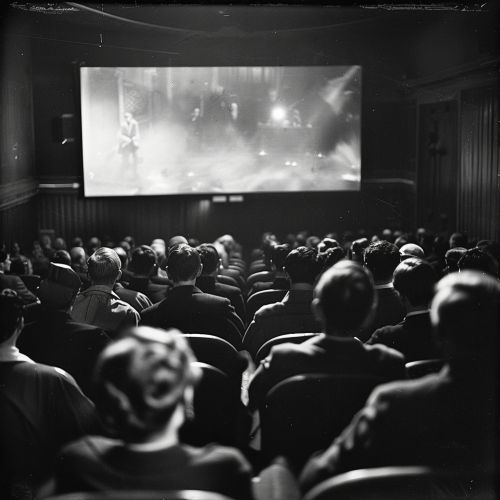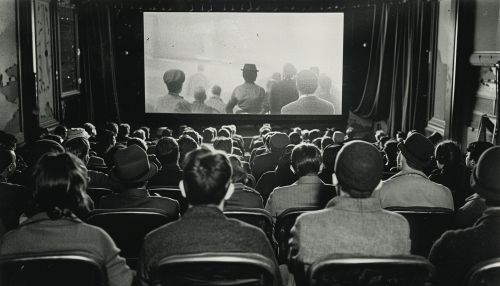Cinema of Europe: Difference between revisions
(Created page with "== History of European Cinema == The history of European cinema is a rich and diverse tapestry that spans over a century, encompassing a wide range of styles, movements, and innovations. European cinema has played a crucial role in the development of the global film industry, influencing and being influenced by various cultural, social, and political factors. === Early Cinema (1890s-1910s) === The origins of European cinema can be traced back to the late 19th century,...") |
No edit summary |
||
| Line 7: | Line 7: | ||
The origins of European cinema can be traced back to the late 19th century, with the pioneering work of inventors and filmmakers such as the Lumière brothers in France and [[Georges Méliès]]. The Lumière brothers are credited with the invention of the [[cinematograph]], a device that could record, develop, and project motion pictures. Their first public screening in 1895 is often regarded as the birth of cinema. | The origins of European cinema can be traced back to the late 19th century, with the pioneering work of inventors and filmmakers such as the Lumière brothers in France and [[Georges Méliès]]. The Lumière brothers are credited with the invention of the [[cinematograph]], a device that could record, develop, and project motion pictures. Their first public screening in 1895 is often regarded as the birth of cinema. | ||
[[Image:Detail-93351.jpg|thumb|center|An early cinema screening with an audience watching a black-and-white film.|class=only_on_mobile]] | |||
[[Image:Detail-93352.jpg|thumb|center|An early cinema screening with an audience watching a black-and-white film.|class=only_on_desktop]] | |||
Georges Méliès, a former magician, is renowned for his innovative use of special effects and narrative storytelling in films like "A Trip to the Moon" (1902). His work laid the foundation for the fantasy and science fiction genres. | Georges Méliès, a former magician, is renowned for his innovative use of special effects and narrative storytelling in films like "A Trip to the Moon" (1902). His work laid the foundation for the fantasy and science fiction genres. | ||
Latest revision as of 10:02, 22 June 2024
History of European Cinema
The history of European cinema is a rich and diverse tapestry that spans over a century, encompassing a wide range of styles, movements, and innovations. European cinema has played a crucial role in the development of the global film industry, influencing and being influenced by various cultural, social, and political factors.
Early Cinema (1890s-1910s)
The origins of European cinema can be traced back to the late 19th century, with the pioneering work of inventors and filmmakers such as the Lumière brothers in France and Georges Méliès. The Lumière brothers are credited with the invention of the cinematograph, a device that could record, develop, and project motion pictures. Their first public screening in 1895 is often regarded as the birth of cinema.


Georges Méliès, a former magician, is renowned for his innovative use of special effects and narrative storytelling in films like "A Trip to the Moon" (1902). His work laid the foundation for the fantasy and science fiction genres.
Silent Era (1910s-1920s)
The silent era saw the rise of influential film movements and studios across Europe. In Germany, the German Expressionism movement emerged, characterized by its use of distorted sets, dramatic lighting, and psychological themes. Notable films from this period include "The Cabinet of Dr. Caligari" (1920) and "Nosferatu" (1922).
In the Soviet Union, filmmakers like Sergei Eisenstein and Dziga Vertov developed groundbreaking techniques in montage and documentary filmmaking. Eisenstein's "Battleship Potemkin" (1925) is celebrated for its innovative use of editing to create emotional impact.
Sound Era and World War II (1930s-1940s)
The advent of sound in the late 1920s brought significant changes to European cinema. In France, the Poetic Realism movement emerged, with directors like Jean Renoir and Marcel Carné creating films that depicted the struggles of everyday life with a lyrical and melancholic tone. Notable works include Renoir's "The Rules of the Game" (1939) and Carné's "Children of Paradise" (1945).
During World War II, European cinema faced numerous challenges, including censorship, propaganda, and the destruction of film infrastructure. Despite these obstacles, filmmakers continued to produce influential works. In Italy, the Neorealism movement emerged in the post-war period, with directors like Roberto Rossellini, Vittorio De Sica, and Luchino Visconti creating films that depicted the harsh realities of life in war-torn Italy. "Rome, Open City" (1945) and "Bicycle Thieves" (1948) are seminal works of this movement.
Post-War Cinema (1950s-1960s)
The post-war period saw the emergence of several influential film movements across Europe. In France, the French New Wave revolutionized cinema with its innovative techniques and emphasis on personal expression. Directors like François Truffaut, Jean-Luc Godard, and Agnès Varda challenged traditional filmmaking conventions with films like "The 400 Blows" (1959) and "Breathless" (1960).
In the United Kingdom, the British New Wave focused on social realism, depicting the lives of working-class individuals. Directors like Tony Richardson, Lindsay Anderson, and Ken Loach created films that addressed social issues and class struggles. Notable works include "Saturday Night and Sunday Morning" (1960) and "Kes" (1969).
Modern European Cinema (1970s-Present)
Modern European cinema is characterized by its diversity and the continued influence of various national cinemas. In the 1970s, the New German Cinema movement emerged, with directors like Rainer Werner Fassbinder, Werner Herzog, and Wim Wenders creating films that explored contemporary German society and history. Fassbinder's "The Marriage of Maria Braun" (1979) and Herzog's "Aguirre, the Wrath of God" (1972) are notable examples.
In the 1990s and 2000s, European cinema continued to thrive with the emergence of new voices and styles. Directors like Pedro Almodóvar in Spain, Michael Haneke in Austria, and Lars von Trier in Denmark gained international acclaim for their distinctive and provocative works. Almodóvar's "All About My Mother" (1999), Haneke's "The White Ribbon" (2009), and von Trier's "Breaking the Waves" (1996) are celebrated films from this period.
Influential Directors and Movements
European cinema has been shaped by numerous influential directors and film movements, each contributing to the evolution of the medium.
French New Wave
The French New Wave (Nouvelle Vague) was a revolutionary film movement that emerged in the late 1950s and 1960s. It was characterized by its rejection of traditional filmmaking conventions and its emphasis on personal expression and experimentation. Key figures of the French New Wave include François Truffaut, Jean-Luc Godard, Claude Chabrol, and Agnès Varda.
The movement was marked by its use of innovative techniques such as jump cuts, handheld cameras, and natural lighting. Films like Truffaut's "The 400 Blows" (1959) and Godard's "Breathless" (1960) are iconic examples of the French New Wave.
Italian Neorealism
Italian Neorealism was a film movement that emerged in the aftermath of World War II. It focused on depicting the everyday lives of ordinary people, often using non-professional actors and on-location shooting. Key directors of Italian Neorealism include Roberto Rossellini, Vittorio De Sica, and Luchino Visconti.
The movement's emphasis on social realism and its portrayal of the struggles of the working class had a profound impact on global cinema. Notable films include Rossellini's "Rome, Open City" (1945) and De Sica's "Bicycle Thieves" (1948).
New German Cinema
The New German Cinema movement emerged in the late 1960s and 1970s as a response to the stagnation of the German film industry. It was characterized by its exploration of contemporary German society, history, and politics. Key figures of the New German Cinema include Rainer Werner Fassbinder, Werner Herzog, and Wim Wenders.
The movement produced a number of critically acclaimed films, such as Fassbinder's "The Marriage of Maria Braun" (1979), Herzog's "Aguirre, the Wrath of God" (1972), and Wenders' "Paris, Texas" (1984).
National Cinemas
European cinema is composed of various national cinemas, each with its own unique characteristics and contributions to the medium.
French Cinema
French cinema has a long and storied history, with its origins dating back to the invention of the cinematograph by the Lumière brothers. France has produced numerous influential filmmakers and movements, including the French New Wave, Poetic Realism, and the works of directors like Jean Renoir, François Truffaut, and Jean-Luc Godard.
French cinema is known for its artistic and experimental approach, as well as its emphasis on auteur theory, which views the director as the primary creative force behind a film.
Italian Cinema
Italian cinema has made significant contributions to the global film industry, particularly through the Italian Neorealism movement. Italy has produced numerous influential directors, including Federico Fellini, Michelangelo Antonioni, and Sergio Leone.
Italian cinema is known for its diverse genres, ranging from the social realism of Neorealism to the stylized excess of Spaghetti Westerns and the surrealism of Fellini's works.
British Cinema
British cinema has a rich history, with its origins dating back to the early 20th century. The British film industry has produced numerous influential directors and movements, including the British New Wave and the works of directors like Alfred Hitchcock, David Lean, and Ken Loach.
British cinema is known for its emphasis on social realism, as well as its contributions to various genres, including horror, comedy, and historical epics.
German Cinema
German cinema has played a crucial role in the development of the medium, particularly through the German Expressionism and New German Cinema movements. Germany has produced numerous influential directors, including Fritz Lang, F.W. Murnau, and Rainer Werner Fassbinder.
German cinema is known for its innovative use of visual style and its exploration of complex themes, such as identity, history, and politics.
Spanish Cinema
Spanish cinema has gained international recognition for its unique and diverse contributions to the medium. Key figures in Spanish cinema include Luis Buñuel, Pedro Almodóvar, and Alejandro Amenábar.
Spanish cinema is known for its bold and provocative storytelling, as well as its exploration of themes such as identity, sexuality, and politics.
Contemporary Trends and Challenges
European cinema continues to evolve in response to changing cultural, social, and technological landscapes. Contemporary trends and challenges in European cinema include the rise of digital filmmaking, the impact of globalization, and the ongoing struggle for funding and distribution.
Digital Filmmaking
The advent of digital technology has revolutionized the film industry, offering new opportunities for filmmakers in terms of production, distribution, and exhibition. Digital filmmaking has made it easier for independent filmmakers to produce and distribute their work, leading to a proliferation of diverse voices and styles in European cinema.
However, the transition to digital has also presented challenges, such as the need for new skills and training, as well as concerns about the preservation of digital media.
Globalization
Globalization has had a significant impact on European cinema, both in terms of the content of films and the structure of the film industry. European filmmakers are increasingly collaborating with international partners, leading to the creation of co-productions and the blending of different cultural influences.
At the same time, European cinema faces competition from Hollywood and other global film industries, which can make it difficult for European films to secure funding and distribution.
Funding and Distribution
Securing funding and distribution remains a major challenge for European filmmakers. Many European countries have established film funds and support programs to help filmmakers finance their projects, but competition for these resources is often fierce.
Distribution is another significant challenge, as European films often struggle to find audiences both domestically and internationally. The rise of streaming platforms has provided new opportunities for distribution, but it has also introduced new challenges in terms of visibility and revenue.
